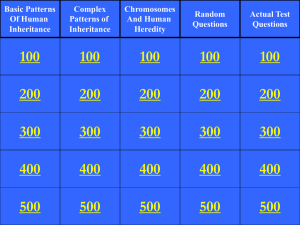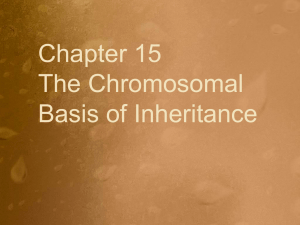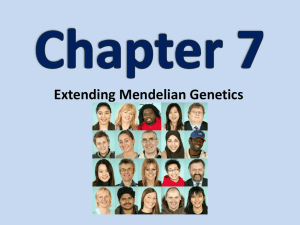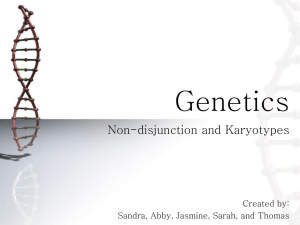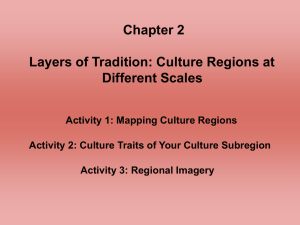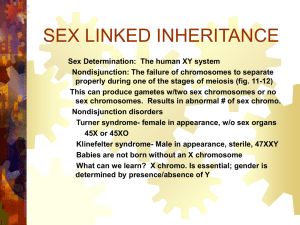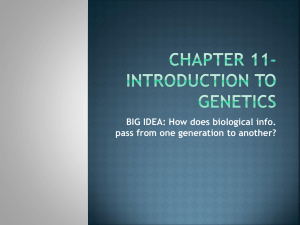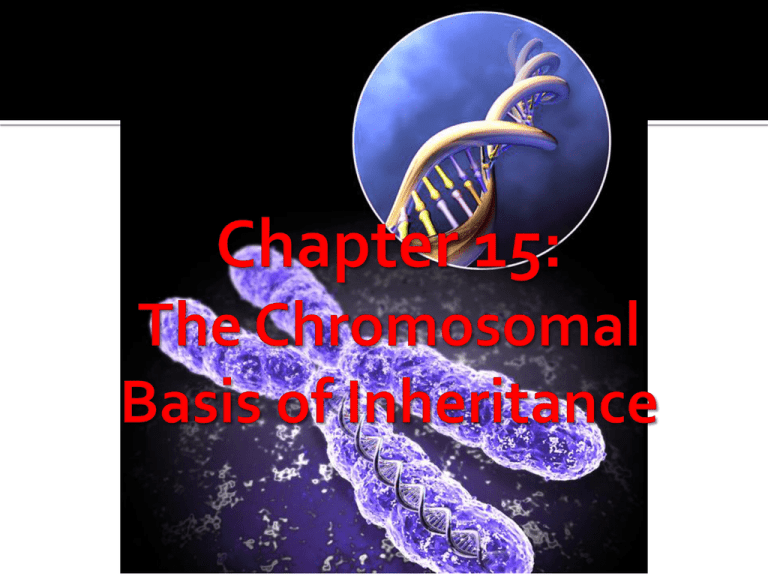
3.a.4 – The inheritance pattern of many traits
cannot be explained by simple Mendelian
genetics (15.1, 15.2, 15.3, 15.5).
3.c.1 – Changes in genotype can result in
changes in phenotype (15.4).
Developed the “Chromosome
Theory of Inheritance”
1) Mendelian factors or alleles are
located on chromosomes
2) Chromosomes segregate and
show independent assortment
Embryologist at Columbia University
Chose to use fruit flies as a test organism in
genetics
Allowed the first tracing of traits to specific
chromosomes
Drosophila melanogaster
Feeds on fungus growing on fruit
Early test organism for genetic studies
Small
Cheap to house and feed
Short generation time
New generation every 2 weeks
100s of offspring produced
Few chromosomes
4 pairs (8 total)
3 pairs autosomes, 1 pair sex
Mendel: use of uppercase or lowercase
letters
T = tall
t = short
Morgan: symbol from the mutant
phenotype
+ = wild phenotype (natural pheno)
No symbol = mutant phenotype (any pheno
different from wild)
Recessive mutation:
w = white eyes
w+ = red eyes
Dominant mutation:
Cy = Curly wings
Cy+ = Normal wings
Letters come from 1st
mutant trait observed
A male fly with a mutation for white eyes
Then, he crossed the white eye male with
normal red eye female
All had red eyes
Same as Mendel’s F1
This suggests that white eyes
is a genetic recessive
Morgan expected the F2 to have a 3:1 ratio of
red:white
He got this ratio
However, all of the white eyed flies were
MALE
Most red eyed flies were FEMALE
Therefore, the eye color trait appeared to be
linked to sex
Sex-linked traits
Genetic traits whose expression are
dependent on the sex of the individual
Genes on sex chromosomes exhibited unique
patterns
Eye color gene
located on X
chromo (with no
corresponding gene
on Y)
There are many genes, but only a few
chromosomes
Therefore, each chromosome must carry a
number of genes together as a “package”
There was a correlation between a
particular trait and an individual’s sex
Traits that are located on the same
chromosome (that tend to be inherited
together)
Result:
Failure of (deviation from) Mendel's
Law of Independent Assortment.
Ratios mimic monohybrid crosses.
Body Color
and Wing type
Wild: gray and normal (dom +)
Mutant: Black and vestigal (rec)
This is why we use “b” for body color
alleles and “vg” for wing alleles
Symbols:
Body color - b+: gray; b: black
Wings - vg+: normal; vg: vestigal
b+b vg+vg X bb vgvg
#1: b+b = gray; vg+vg = normal
#2: bb = black; vgvg = vestigal
(b+ linked to vg+)
(b linked to vg)
If unlinked: 1:1:1:1 ratio.
If linked: ratio will be altered
Occurs during Pro I of
meiosis
Breaks up linkages and
creates new ones
Recombinant offspring
formed that doesn't
match the parental
types
Independent Assortment of traits fails
Linkage may be “strong” or “weak”
Degree of strength related to how close the
traits are on the chromosome
Weak - farther apart
Strong - closer together
Usually located closer to centromere
Constructed from crossing-over
frequencies
1 map unit = 1% recombination frequency
Have been constructed for many traits in
fruit flies, humans and other organism.
Several systems are known:
Mammals – XX and XY
Diploid insects – X and XX
3. Birds – ZZ and ZW
4. Haploid-Diploid
1.
2.
1.
Mammals
Determined by whether sperm has X or Y
2.
Diploid insects
Only X chromosomes present
3.
Birds
Egg determines sex
4.
Haploid-Diploid
Females develop from fert egg
Males develop from unfert egg
Sex determination ALWAYS 50-50
X chromosome - medium sized
chromosome with a large number of
traits
Y chromosome - much smaller
chromosome with only a few traits
Eggs – only contain X
Sperm – either X or Y
Males - XY
Females - XX
Comment - The X and Y chromosomes
are a homologous pair, but only for a
small region at one tip
Inheritance of traits on the sex
chromosomes
NOT TO BE CONFUSED WITH sex-linked traits!!!!!
X Linkage - common; Y- rare
Dads: only to daughters (b/c dads ONLY
give X chromo to daughters)
Moms: to either sex
Hemizygous - 1 copy of X chromosome
Show ALL X traits (dominant or recessive)
More likely to show X recessive gene
problems than females
Disorders on X-chromo:
Color blindness
Duchenne's Muscular Dystrophy
Hemophilia (types a and b)
Patterns
Trait is usually passed from a carrier mother to 1
of 2 sons
Affected father has no affected sons, but passes
the trait on to all daughters (who will be carriers
for the trait)
Watch how questions with sex linkage are
phrased:
Chance of children?
Chance of males?
Chance of females?
You MUST practice genetics problems
w/ these traits: Hemophilia, Muscular
dystrophy and colorblindness (they all
work the same!)
Yes!!!
ONLY if their mother was a carrier and
their father is affected
How? Mother contributes X (with
affected allele) and dad contributes all
he can to make a daughter – affected X
25
45
6
29
56
8
Hairy ear pinnae
Comment - new techniques have found a
number of Y-linked factors that can be
shown to run in the males of a family
Ex: Jewish priests
Traits that are only expressed in one sex
Ex: prostate development, gonad
specialization, fallopian tube development
Traits whose expression differs because of
the hormones of the sex
Ex: beards, mammary gland development,
baldness
Baldness:
Testosterone – makes the trait act as a dominant
No testosterone – makes the trait act as a
recessive
Males – have gene = bald
Females – must be homozygous to have thin hair
(rare)
In every somatic cell (in females), one X
chromosome is inactivated
Humans: differs/random
Kangaroos: always paternal X that is
inactivated
Called Barr bodies
Inactive X chromosome observed in the
nucleus
▪ Becomes inactive during embryonic
development
Way of determining genetic sex
(without doing a karyotype)
Compact body which lies close to nuclear
envelope
Most genes on this X are NOT expressed
Inside developed ovaries, these are
reactivated (so that each ova will get an
active X)
Which X inactivated is random
Inactivation happens early in embryo
development by adding CH3 groups to
the DNA
Changes DNA nucleotide
Result - body cells are a mosaic/combo
of X types
Some have active X from mom, others active X
from dad
Calico Cats
Human examples are known (sweat gland
disorder)
Why don’t you find many calico
males?
They must be XB XOY and are always
sterile
Why?
They MUST have an extra X chromo
(to have an inactive X - you must
have TWO!)
Two types of alterations:
Changes in number
Changes in structure
Aneuploidy - too many or too few
chromosomes, but not a whole “set” change
Polyploidy - changes in whole “sets” of
chromosomes
Caused by nondisjunction
the failure of a pair of chromosomes to separate
during meiosis
Result: too many or too few chromosomes in a
gamete
Nondisjunction in Meiosis I produces 4
abnormal gametes.
Nondisjunction in Meiosis II produces 2
normal and 2 abnormal gametes.
Monosomy: 2N – 1 (very rare)
Mono = one (missing copy)
Trisomy: 2N + 1 (more common)
Tri = three (extra copy)
Normal: 2N
Monosomy
2N - 1 or 45 chromosomes
Genotype: X_ or X0
Phenotype: female, but very poor secondary
sexual development.
Characteristics:
Short stature.
Extra skin on neck.
Broad chest.
Usually sterile
Normal mental development except for some spatial
problems.
Why are Turner Individuals usually sterile?
Odd chromosome number
Two X chromosomes needed for ovary
development.
Kleinfelter Syndrome
Meta female
Supermale
Trisomy
2N + 1 (2N + 2, 2N + 3)
Genotype: XXY (XXXY, XXXXY)
Phenotype: male, sexual development
may be poor/slow
Often taller than average, mental
development fine (in XXY), usually
sterile
More X = more mental problems
May have been a Kleinfelter Syndrome
individual.
Much taller than average
Produced no children/sterile individual
Trisomy
2N + 1 or 2N + 2
Genotype: XXX or XXXX
Phenotype: female, but sexual development
poor.
Mental impairment common.
Trisomy
2N + 1 or 2N + 2
Genotype: XYY or XYYY
Phenotype: male, usually normal
development, fertile w/ normal sex organ
development
Trisomy 21: Down Syndrome
Trisomy 13: Patau Syndrome
Both have various physical and mental
changes
Increases with maternal age (especially above
35)
How? An embryo’s ovaries are halted in meiosis I
(during egg development)
When ovulation occurs, the eggs resume meiosis
and nondisjunction occurs then
This is why it is often seen more in older women
Mental retardation
Heart defects
Characteristic facial features
Why is trisomy more common than
monosomy?
Fetus can survive an extra copy of a chromosome,
but being hemizygous for somatic cell is usually
fatal
Why is trisomy 21 more common in
older mothers?
Maternal age increases risk of nondisjunction
Triploid= 3N
Tetraploid= 4N
Usually fatal in animals
Cells receive AN ENTIRE EXTRA COPY of all
homologous chromosomes (including sex
chromo)
In plants, even # polyploids are often
fertile, while odd # polyploids are sterile.
Why?
Odd number of chromosomes can’t
be split during meiosis to make
spores.
Deletions: loss of genetic info
Duplications: extra copies of genetic info
Inversions and translocations:
Position effects: a gene's expression is
influenced by its location to other genes
Part of p arm of #5 missing
Deletion chromosomal abnormality
Good survival rate
Severe mental retardation
Small sized heads common
Malformed larynx w/ vocal/speech problems
Part of X chromo is missing
Deletion
Sterile
Mental retardation
Oversized testes (if male); ovaries (if
female)
“Double jointedness”
Caused by translocation
An abnormal chromosome produced by an
exchange of portions of chromosomes 9 and
22
Causes chronic myeloid leukemia
Gene expression and inheritance depends on
which parent passed on the gene
Usually caused by different methylations of
the DNA
CAUSE:
Imprints are "erased" in gamete producing cells
and re-coded by the body according to its sex
RESULT:
Phenotypes don't follow Mendelian Inheritance
patterns because the sex of the parent does
matter
Prader-Willi Syndrome and
Angelman Syndrome
Both lack a small gene region from
chromosome 15
Male gene contribution missing: Prader-Willi
Female: Angelman
Method that cells might use to detect that
TWO different sets of chromosomes are in
the zygote
Inheritance of genes not located on the
nuclear DNA
Where does it come from?
DNA in organelles (Mitochondria and chloroplasts)
Result:
Mendelian inheritance patterns fail.
Maternal Inheritance of traits where the trait is
passed directly through the egg to the offspring
Myoclonic Epilepsy
Ragged Red-fiber Disease
Leber’s Optic Neuropathy
All are associated with ATP generation
problems and affect organs with high ATP
demands
Muscle, brain
Gives non-green areas in leaves
Called variegation
Several different types known
Very common in ornamental plants
Recognize the relationships between Mendelian
inheritance patterns and chromosomes.
Identify linked genes and their effect on inheritance
patterns.
Recognize the chromosomal basis of recombination
in unlinked and linked genes.
Recognize how crossover data is used to construct a
genetic map.
Identify the chromosomal basis of sex in humans.
Recognize examples of sex-linked disorders in
humans.
Identify X-inactivation and its effect in females.
Recognize sources and examples of
chromosomal alterations in humans.
Identify examples of abnormalities in sex
chromosome number in humans.
Recognize the basis and effects of parental
imprinting of genes in human inheritance
patterns.
Recognize the basis and effect of extranuclear
inheritance on genetic inheritance patterns.

